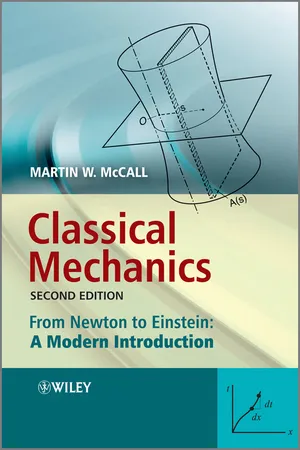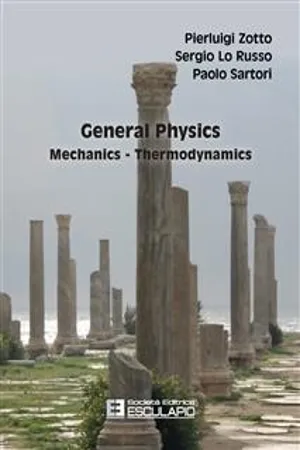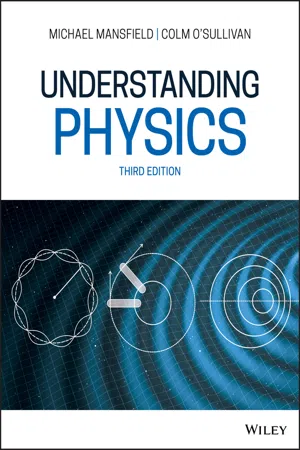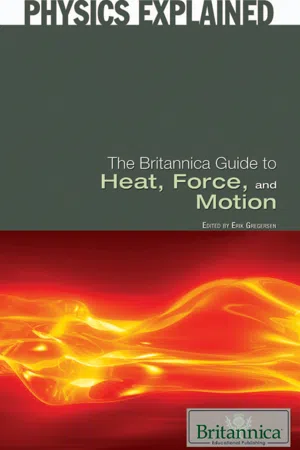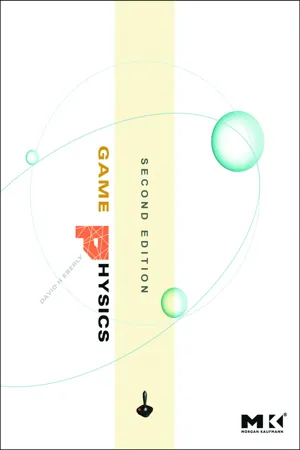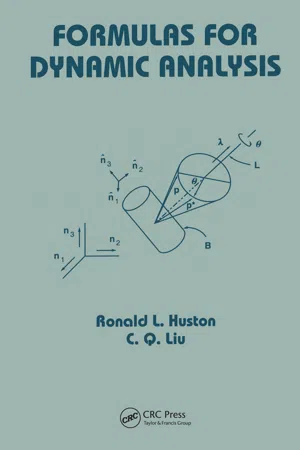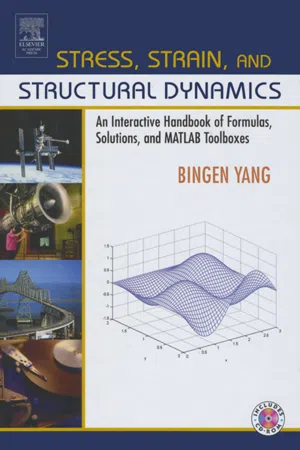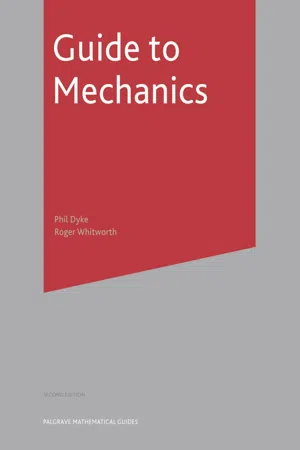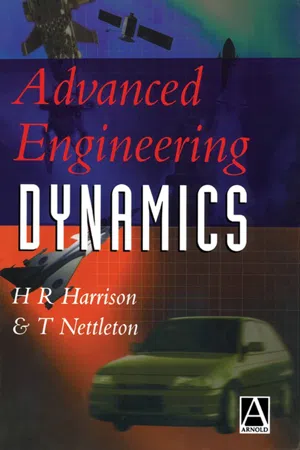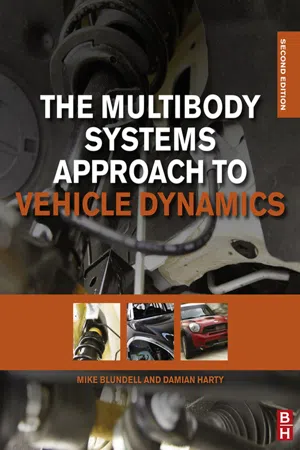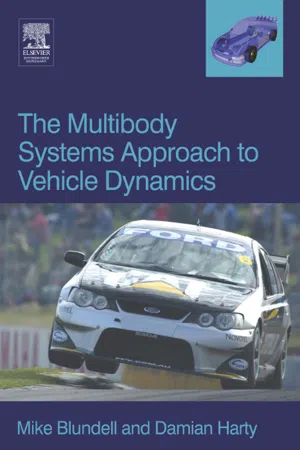Physics
Rigid Body Dynamics
Rigid body dynamics is a branch of physics that deals with the motion and forces experienced by solid objects that maintain their shape. It focuses on analyzing the movement of rigid bodies, considering factors such as rotation, translation, and the forces acting upon them. This field is essential for understanding the behavior of objects in motion and is widely used in engineering and physics.
Written by Perlego with AI-assistance
Related key terms
1 of 5
12 Key excerpts on "Rigid Body Dynamics"
- eBook - ePub
Classical Mechanics
From Newton to Einstein: A Modern Introduction
- Martin W. McCall(Author)
- 2011(Publication Date)
- Wiley(Publisher)
8 Rigid Body Dynamics 8.1 IntroductionWe noted in the previous chapter the complexity of Newton’s second law applied in three dimensions. Matters are even more complicated when many particles are present, for then Equations (7.1 ) must be written down for each and every particle in the system. Along with Equations (7.1 ), the initial positions and velocities of every particle must also be specified. In principle, the evolution of the system is then known precisely. However, simply the number of equations and initial conditions excludes this ‘brute force’ approach as a practical method of calculation. In Chapter 4, we achieved some simplification through dividing two-body motion into external and internal motions, and to some extent this method can be applied to systems with more than two particles present. In this chapter we are going to simplify the billions of equations by imposing a constraint on the many-particle system. Suppose that all the particles comprising a system are locked together with rods that never buckle, stretch or otherwise deform. Consequently, the particles are no longer free to move independently of each other; if one moves, then all the others must respond instantaneously. Such an idealisation of a many-particle system is called a rigid body.- A rigid body is defined as a system in which forces act so as to maintain the distances between its constituent particles.
A rigid body is indeed an idealisation. All extended bodies deform a little when subjected to forces, and of course the notion that any spatially separated particles can respond instantaneously to each other violates relativity. Nevertheless, providing we keep these limitations in mind, the rigid body concept is very useful. We must not get carried away, though. You might think that if all the bodies respond to each other at the same time, then effectively the dynamical problem reduces to that of a single particle. This is not so. A force applied to the centre of mass of a rigid body does indeed cause the body as a whole to accelerate. However, an external force acting through any other point exerts a torque about the centre of mass that causes the body to spin (see Figure 8.1 ). The spinning motion maintains the spatial separations, as required for a rigid body, but has no analogue for single-particle systems. Nevertheless, the problem has - eBook - PDF
- Pierluigi Zotto, Sergio Lo Russo, Paolo Sartori(Authors)
- 2022(Publication Date)
- Società Editrice Esculapio(Publisher)
Dynamics of a Rigid Body 8.1 Introduction Any apparently compact body actually consists of molecules which are, from a mechan- ics point of view, components of a very small size, thus we can study its behaviour as a system of particles whose dynamics can be simplified in two specific cases: a) the structure and the size of the body are irrelevant to describe its motion: if this con- dition occurs, the body can be considered as a point-like particle; b) the size of the body is relevant: in this case we can approximate the structure of the system to a continuous body, neglecting its molecular composition and consequently the approximation to point-like particles of the molecules themselves. The situation falling into the former case can be dealt with by using the results of kine- matics and dynamics covered in the previous chapters, while in the latter case the logical approach must be modified. Consider a large sized body and divide its volume into infini- tesimal elements of mass dm and volume dV = dx dy dz. The posi- tion of each volume element is identified by its position vector r = x u x + y u y + z u z , thus for each infinitesimal volume located on the body we can define the density function ρ x, y, z, t ( ) = dm dV where we must add a time dependence, since the mass of any infinitesimal volume may change while the observation proceeds, due to molecules entering or exiting volume dV. Density ρ expresses the mass per unit volume of a body, but, as a consequence of our approximation, in some cases one or more geometrical dimensions can be neglected: in the case of plates a body can be approximated by a surface distribution of mass and, in the case of wires, an approximation to a linear mass distribution is allowed. - eBook - ePub
- Michael M. Mansfield, Colm O'Sullivan(Authors)
- 2020(Publication Date)
- Wiley(Publisher)
7 Rigid Body DynamicsAIMS
- To show how the principles governing the motion of many‐body systems, discussed in the previous chapter, can be applied to the motion of rigid bodies
- To develop a formalism for the treatment of the motion of a rigid body about a fixed axis
- To outline the formal equivalence between the principles which determine the motion of rigid bodies about a fixed axis and those which determine the motion of a point particle, as discussed in earlier chapters
- To consider the more complicated situation where the axis of rotation is not fixed, as in the case of gyroscopic motion
7.1 Rigid bodies
A rigid body is a many‐body system in which the distance between each pair of particles remains fixed, that is, the system keeps its shape despite the action of any external forces. The motion of such a system under the influence of a net external forceFEXTand of a net momentMEXTis determined by the Equations (6.5) and (6.25) which were derived in the previous chapter, namely(7.1)and(7.2)In Equation (7.1) P is the total momentum which is related toVC, the velocity of the centre of mass of the rigid body, by Equation (6.16) and hence, from Equation (6.17) ,(7.3)where ℳ is the mass of the body. Note that, in this and in some subsequent sections, the symbol ℳ is used for the mass of a body to avoid any possible confusion with the symbol for moment (M).As an example of a rigid body, consider a body of arbitrary shape, as illustrated in Figure 7.1 , which can be thought of as comprising a large number of particles of massesm1 , m2 , m3 ,… etc. If all of the body is near the Earth's surface so that g is effectively constant over its extent, then each component mass miof a body near the Earth's surface experiences a forcem. In the absence of any other external forces, the net external force on the body is given by , where is the mass of the body. The net external moment, relative to the origin O, is given byig - eBook - ePub
- Britannica Educational Publishing, Erik Gregersen(Authors)
- 2010(Publication Date)
- Britannica Educational Publishing(Publisher)
CHAPTER 5 RIGID BODIEST he previous chapter discussed mechanics in terms of particles. However, many objects are not particles but what physicists call rigid bodies. A body is formally regarded as rigid if the distance between any set of two points in it is always constant. In reality no body is perfectly rigid. When equal and opposite forces are applied to a body, it is always deformed slightly. The body’s own tendency to restore the deformation has the effect of applying counterforces to whatever is applying the forces, thus obeying Newton’s third law. Calling a body rigid means that the changes in the dimensions of the body are small enough to be neglected, even though the force produced by the deformation may not be neglected.STATICS
Statics is the study of bodies and structures that are in equilibrium. For a body to be in equilibrium, there must be no net force acting on it. In addition, there must be no net torque acting on it.When a body has a net force and a net torque acting on it owing to a combination of forces, all the forces acting on the body may be replaced by a single (imaginary) force called the resultant, which acts at a single point on the body, producing the same net force and the same net torque. The body can be brought into equilibrium by applying to it a real force at the same point, equal and opposite to the resultant. This force is called the equilibrant.(A) A body in equilibrium under equal and opposite forces. (B) A body not in equilibrium under equal and opposite forces . Copyright Encyclopædia Britannica; rendering for this edition by Rosen Educational ServicesThe resultant force ( F R ) produces the same net force and the same net torque about point A as F 1 + F 2 ; the body can be brought into equilibrium by applying the equilibrant forceFe - eBook - PDF
- David H. Eberly(Author)
- 2010(Publication Date)
- CRC Press(Publisher)
C h a p t e r 3 Rigid Body Motion C hapter 2 introduced the topic of kinematics, the motion of a body along a path in the absence of external forces. Given the position, we can compute velocity and acceleration by differentiation. This chapter is about dynamics, the interaction of rigid bodies when forces and torques are present in the physical system. The classi- cal approach in an introductory physics course uses Newtonian dynamics and the famous formula of Newton’s second law of motion, F = ma, where m is the con- stant mass of an object, a is its acceleration, and F is the applied force. The applied force determines the acceleration of the object, so velocity and position are obtained by integration, exactly the opposite process we saw in kinematics. The coverage of Newtonian dynamics is brief yet sufficient to support the general purpose physics engines that use Newton’s second law for simulation as described in Chapter 6. The majority of this chapter is on the topic of Lagrangian dynamics, a frame- work for setting up the equations of motion for objects when constraints are present. In Lagrangian dynamics, the equations of motion are derived from the kinetic energy function and naturally incorporate the constraints. A Newtonian formulation requires that forces of constraint be part of the term F in the equation of motion; the constraint forces are sometimes difficult to derive. Frictional forces are difficult to deal with in a general purpose physics engine that uses Newtonian dynamics. In the Lagrangian approach, frictional forces are easier to deal with. An entire section is devoted to various examples involving objects moving on a rough plane, that is, a plane whose material causes frictional forces. A game designer’s specific knowledge of what the game physics will entail can exploit that knowledge to good effect by formulating the simulations using Lagrangian dynamics. The result is that the computational time of the simulation © 2010 by Elsevier Inc. - eBook - ePub
- Tom W B Kibble, Frank H Berkshire(Authors)
- 2004(Publication Date)
- ICP(Publisher)
Chapter 9Rigid BodiesThe principal characteristic of a solid body is its rigidity. Under normal circumstances, its size and shape vary only slightly under stress, changes in temperature, and the like. Thus it is natural to consider the idealization of a perfectly rigid body, whose size and shape are permanently fixed. Such a body may be characterized by the requirement that the distance between any two points of the body remains fixed. In this chapter, we shall be concerned with the mechanics of rigid bodies.9.1Basic PrinciplesIt will be convenient to simplify the notation of the previous chapter by omitting the particle label i from sums over all particles in the rigid body. Thus, for example, we shall writein place of (8.3) and (8.11). The motion of the centre of mass of the body is completely specified by (8.6):Our main interest in this chapter will be centred on the rotational motion of the rigid body. For the moment, let us assume, as we originally did in §8.3 , that the internal forces are central. Then, according to (8.14),We shall see later that these two equations are sufficient to determine the motion completely.One very important application of (9.1) and (9.2) should be noted. For a rigid body at rest, = 0 for every particle, and thus both P and J vanish. Clearly, the body can remain at rest only if the right hand sides of both (9.1) and (9.2) vanish, i.e., if the sum of the forces and the sum of their moments are both zero. In fact, as we shall see, this is not only a necessary, but also a sufficient, condition for equilibrium.Under the same assumption of central internal forces, we saw in §8.5 that the internal forces do no work, so thatThis might at first sight appear to be a third independent equation. However, we shall see later that it is actually a consequence of the other two. It is of course particularly useful in the case when the external forces are conservative, since it then leads to the conservation law - eBook - PDF
- Ronald Huston, C Q Liu(Authors)
- 2001(Publication Date)
- CRC Press(Publisher)
Chapter 10 Rigid Body Dynamics 10.1 Introduction In this chapter we list commonly used formulas for dynamics analyses of rigid bodies. These formulas arise from basic principles of physics (mechanics) and the corresponding laws of motion. In subsequent chapters we will extend these concepts for the analysis of systems of rigid bodies — that is, multibody systems. Initially we review the principles themselves. We then explore the various terms in the formulas and equations expressing the principles. We illustrate the principles with a series of sample classical examples in the following chapter. 10.2 Principles of Dynamics/Laws of Motion As noted with the dynamics of particles (see Chapter 5) most principles of dynamics have their roots in Newton's laws — particularly, Newton's second law. In this sense they are equivalent to one another. Table 10.2.1 provides a listing of commonly used principles/laws/formulas as they are applied in Rigid Body Dynamics. References [10.2-10.32] provide sources for these and less commonly used principles. 412 Rigid Body Dynamics 413 Table 10.2.1 Principles of Dynamics/Laws of Motion and Formulas for Rigid Bodies Reference Name Principle/Statement Formulas/Notes Equations 1. Newton's Acceleration af of Fi = miai, i= 1,...,N Second Law each particle P}of a (N is the number of body B is proportional particles in B.) to the resultant of N the forces on the Alternatively, ^ (5.2.2) particle and inversely i=l (9.12.11) proportional to the = maG and MG = mass m i of the particle. IGa ~ co x (IG • co). G is the mass center of B, m is the mass of B, IG is the central inertia dyadic, MG is the resultant of moments of the applied forces about G, co is the angular velocity of B in an inertial reference frame R, and a is the angular acceleration of B in R. ( 1 0 . 2 . 1 ) 414 Chapter 10 Reference Name Principle/Statement Formulas/Notes Equations 2 . - eBook - ePub
Stress, Strain, and Structural Dynamics
An Interactive Handbook of Formulas, Solutions, and MATLAB Toolboxes
- Bingen Yang(Author)
- 2005(Publication Date)
- Academic Press(Publisher)
Section 9.6 .9.2 Dynamics of Particles
9.2.1 PreliminariesUnits
Some commonly used quantities in engineering mechanics are listed in Table 9.2.1 , where units in both the Standard International (SI) and U.S. Customary Systems are shown.TABLE 9.2.1 UnitsNewton’s Laws
Classical mechanics was established based upon the following three laws of motion that were first stated by Isaac Newton in 1687:First Law: A particle remains at rest or moves with a constant velocity along a straight line if the sum of the forces acting on it is zero.Second Law: The rate of change of the linear momentum of a particle is equal to the sum of the forces acting on it.Third Law: The forces exerted by two particles upon each other, which are called the action and reaction forces, are equal in magnitude, opposite in direction, and collinear.Mathematically, Newton’s second law is expressed by(9.1)where m and ν are the mass and velocity of the particle, respectively; F is the resultant or sum of all forces acting on the particle; and mv is the linear momentum of the particle. If the mass m is constant, Eq. (9.1) becomes(9.2)where is the acceleration of the particle. Equation (9.2) is a commonly used expression of Newton’s second law, which indicates that the acceleration of a particle of constant mass is proportional to the resultant force.Besides Newton’s laws of motion, Newton’s law of gravitation is also important in dynamics, especially in orbital dynamics; see Sec. 9.2.6 .Force
The motion of a particle or body is caused by forces. A force is an action of pull or push applied by one body to another. A force is characterized by its magnitude, direction of action, and point of application. Thus, forces can be expressed by vectors, and superposition of forces follows the parallelogram rule of vector summation. For instance, the sum of forces F 1 and F 2 in Fig. 9.2.1(a) is obtained by the diagonal of the parallelogram formed by the forces, as shown in Fig. 9.2.1(b) - eBook - PDF
- Philip Dyke, Roger Whitworth(Authors)
- 2017(Publication Date)
- Red Globe Press(Publisher)
Further work can be carried out when these properties are applied to the many problems of general motion, however the principles involved will not be explored here as they belong securely in more advanced texts (see Phil Dyke's, Work Out Mechanics , Macmillan ± now Palgrave, 1995). Here, we shall be content to consider a simple case of a rigid body travelling in a two-dimensional plane, where the position vector of the centre of mass is in Cartesian form so that: r x y and the velocity and acceleration of the centre of mass are respectively: _ r _ x _ y and r x y The angle of rotation about an axis perpendicular to the plane of Ox and Oy is and the corresponding angular velocity and angular acceleration are _ and . Newton's laws relating force couples and acceleration applied to the planar motion of a rigid body of mass m whose moment of inertia about an axis through its centre of mass is I give: Translation (linear momentum): impulse change in linear momentum Rotation (angular momentum): moment of impulse change in angular momentum Recall the practical exploration of the motion of the rule at the beginning of this chapter. The following example explores the dynamics of the same pro-blem. An Introduction to Rigid Body Dynamics 281 Example 10.19 A thin uniform rod AB of mass m and length 2 a rests in equilibrium on a smooth horizontal plane. An impulse J acts in the horizontal plane on the rod at A perpendicular to AB . Find (a) the result-ing motion of the rod and (b) the linear velocity of the ends A and B immediately after the impact (see Figure 10.30). Solution (a) Immediately after the impulse has been applied: (i) i the centre of mass of the rod moves with velocity: v u v (ii) the angular speed of the centre of mass of the rod is ! . - eBook - ePub
- H. Harrison, T. Nettleton(Authors)
- 1997(Publication Date)
- Butterworth-Heinemann(Publisher)
4Rigid Body Motion in Three Dimensions
4.1 Introduction
A rigid body is an idealization of a solid object for which no change in volume or shape is permissible. This means that the separation between any two particles of the body remains constant.If we know the positions of three non-colinear points, i, j and k , then the position of the body in space is defined. However, there are three equations of constraint of the form |ri −rj| = constant so the number of degrees of freedom is 3 × 3 − 3 = 6.4.2 Rotation
If the line joining any two points changes its orientation in space then the body has suffered a rotation. If no rotation is taking place then all particles will be moving along parallel paths. If the paths are straight then the motion is described as rectilinear translation and if not the motion is curvilinear translation. From the definitions it is clear that a body can move along a circular path but there need be no rotation of the body.It follows that for any pure translational motion there is no relative motion between individual particles. Conversely any relative motion must be due to some rotation.The rotation of a rigid body can be described in terms of the motion of points on a sphere of radius a centred on some arbitrary reference point, say i . The body, shown in Fig. 4.1 , is now reorientated so that the points j and k are moved, by any means, to positions j′ and k′ . The arc of the great circle joining j and k will be the same length as the arc joining j′ and k′, by definition of a rigid body. Next we construct the great circle through points j and j′ and another through the points k and k′ . We now draw great circles which are the perpendicular bisectors of arcs jj′ and kk′ . These two circles intersect at point N. The figure is now completed by drawing the four great circles through N and the points j, k, j′ and k′ respectively.Fig. 4.1By the definition of the perpendicular bisector arc Nj = arc Nj′ and arc Nk = arc Nk′ . Also arc jk = arc j′k′ and thus it follows that the spherical triangle k Nj is congruent with k′ Nj′ . Now the angle k Nj = k′ Nj′ and the angle k Nj′ is common; therefore angle k Nk′ = j Nj′ - Michael Blundell, Damian Harty(Authors)
- 2014(Publication Date)
- Butterworth-Heinemann(Publisher)
Chapter 2Kinematics and Dynamics of Rigid Bodies
Abstract
Chapter 2 is included for completeness and covers the underlying formulations in kinematics and dynamics required for a good understanding of multibody systems formulations. A three-dimensional vector approach is used to develop the theory, this being the most suitable method for developing the rigid body equations of motion and constraint formulations described later.Keywords
Acceleration analysis; Dynamics of a particle; Equations of motion; Geometry analysis; Static force and moment definition; Theory of vectors; Velocity analysisMy God, it's full of stars! Dave Bowman, 2001: A Space Odyssey2.1. Introduction
The application of a modern multibody systems (MBS) computer program requires a good understanding of the underlying theory involved in the formulation and solution of the equations of motion. Due to the three-dimensional nature of the problem the theory is best described using vector algebra. In this chapter the starting point will be the basic definition of a vector and an explanation of the notation that will be used throughout this text. The vector theory will be developed to demonstrate, using examples based on suspension systems, the calculation of new geometry and changes in body orientation, such as the steer change in a road wheel during vertical motion relative to the vehicle body. This will be extended to show how velocities and accelerations may be determined throughout a linked three-dimensional system of rigid bodies. The definition of forces and moments will lead through to the definition of the full dynamic formulations typically used in a MBS analysis code.2.2. Theory of vectors
2.2.1. Position and relative position vectors
- Michael Blundell, Damian Harty(Authors)
- 2004(Publication Date)
- Butterworth-Heinemann(Publisher)
2.6 Static force and moment definition Before progressing to the development of the equations of motion associated with large displacement rigid body dynamic motion it is necessary to exam-ine the use of vectors for static analysis in multibody systems. In this case we define static analysis as the study of forces acting on a body or series of bod-ies where motion takes place in the absence of acceleration. That is a system that is either at rest or moving in a straight line with constant velocity. In order to demonstrate the use of vectors for representation of forces con-sider the following example, shown in Figure 2.22, which involves a tripod structure comprising three links with ball or spherical joints at each end. Before attempting any analysis to determine the distribution of forces it is necessary to prepare a free-body diagram and label the bodies and forces in an appropriate manner as shown in Figure 2.23. The notation used here to describe the forces depends on whether the force is an applied external force (action-only force) or an internal force resulting from the interconnection of bodies (action–reaction force). In this example we have an applied force at point A. In order to fully define a force we must be able to specify the point of application, the line of sight and the sense of the force. In this case we can use the notation { F A } 1 to define the force where the subscript A defines the point of application and the components of the vector F Ax , F Ay and F Az would define both the line of sight and the sense of the force. Where the force is the result of an interaction we can use, for example, the following { F A 52 } 1 which specifies that the force is acting at A on Body 5 due to its interaction with Body 2. Note that for this example we are assum-ing that A is a point that could be, for example, taken to be at the centre of a bush or spherical joint.
Index pages curate the most relevant extracts from our library of academic textbooks. They’ve been created using an in-house natural language model (NLM), each adding context and meaning to key research topics.
